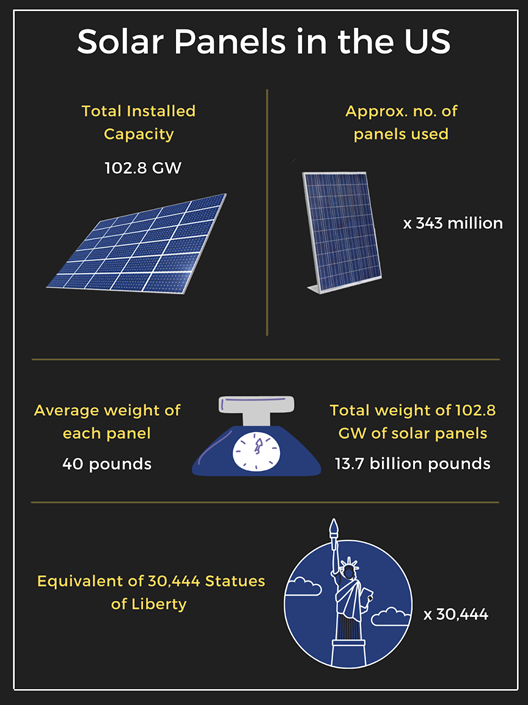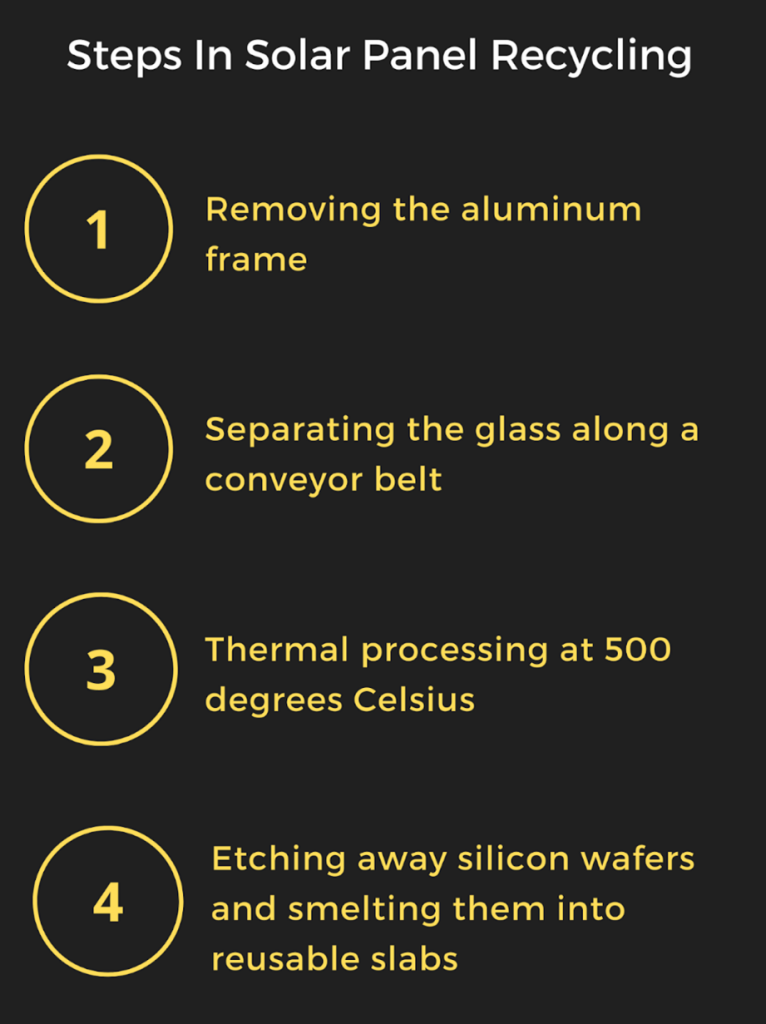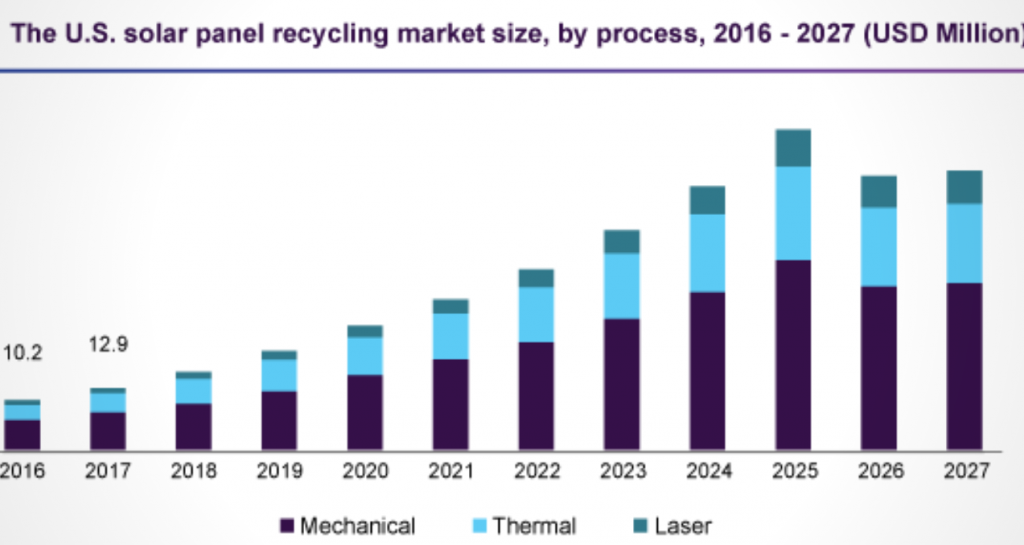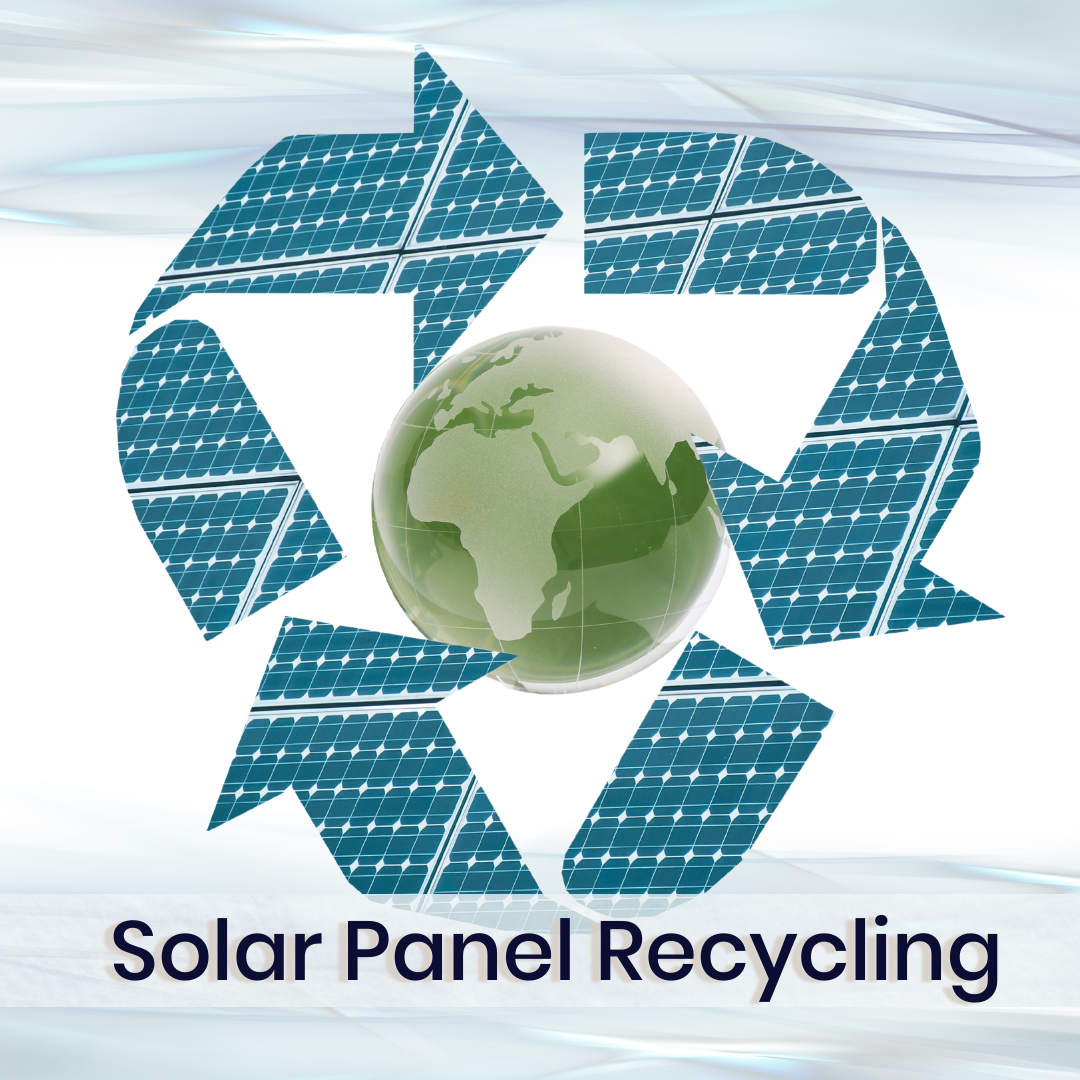In the spring of 1954, a small team at Bell Labs finished work on the world’s first silicon photovoltaic cell – the building block of solar panels. Little did anyone know that the coming decades (mainly the coming century) would churn out billions of solar cells in millions of panels, helping solar break all records [1] of annual installed capacity and stand on the cusp of becoming the single largest power source of the world. However, a critical question accompanies the dramatic rise of solar energy, just as it does for anything proliferating – “What happens to the millions of solar panels when their life ends?”. That answer lies in Solar Panel Recycling.
In Q1 of 2021, the cumulative capacity of installed solar in the U.S. stood at a staggering 102.8GW [2]. Considering an average panel size of 300W, that’s close to 343 million solar panels – equivalent to over 30,000 statues of liberty!

So what exactly happens 25 years from now, when all these panels retire?
Opponents of renewable energy often consider this their favorite question, while proponents slightly sweat when answering it, and for a good reason. Like most other electronics, solar panels are built from a complex array of mostly non-degradable components, and dumping them in landfills is far from the best option.
Right now, the best option (or the least bad option) is to recycle as much of the solar panel as possible. The good news is that 80-100% of solar panels can be recycled. The bad news is that the speed of Solar Recycling is yet to match the speed of panel manufacturing.
But we still have time, and conscious planning and action can help us be ready to handle the overwhelming amount of solar panel waste in another decade or two.
Understanding the Basics of Solar Panel Recycling
Here’s a brief depiction of what happens when a solar panel enters a recycling facility:

As mentioned, solar panels do not degrade naturally, at least yet, since they are made from various inorganic substances. Following is the breakdown of a typical crystalline solar panel’s composition by weight:
| Glass | 76% |
| Plastic | 10% |
| Aluminum | 8% |
| Silicon | 5% |
| Metals | 1% |
Here’s what happens to each of the components when the solar panel goes to a solar panel recycling facility and beyond:
Glass: Separated during disassembly, 95% reused.
Aluminum and other metals: Separated during disassembly, 100% reused.
Silicon: Separated during thermal processing, etched and melted, 85% reused for:
- New solar panels
- Batteries
- Other electronics
Plastic: Evaporated during thermal processing, high-temperature fumes are reused as a heat source.
Among the above materials, the most interesting is silicon, firstly because it has multiple uses in its reincarnated life, secondly, because it can be extracted with a surprising level of purity – 99.9999% (also known as 6 nines or 6N), and finally because it promises to open a new door for a complimentary sustainable technology – electric vehicles.
Silicon can be used in electric cars in the anode of lithium-ion batteries [3], where they promise to improve battery range by up to a striking 20%. A few years ago, Elon Musk reported that silicon in batteries improved range by about 6%, a story reiterated by both Daimler and BMW.
Building a Fool-Proof Recycling Mechanism
A robust recycling mechanism, or any mechanism for that matter, is never only about what is technologically possible. There are a ton of other factors that contribute to creating an excellent recycling infrastructure.

Let’s discuss each of these in a bit more detail:
1) Innovation in the recycling mechanism
Let’s face this harsh truth – no awareness or regulations can drive something unless it is commercially feasible. It is the same reason why solar power took a few decades to gain momentum and grow exponentially as a power source.
Currently, Recycling is a costly affair. As Meng Tao, a solar researcher at Arizona State University, puts it, “We believe the big blind spot in the U.S. for recycling is that the cost far exceeds the revenue; it’s on the order of a 10-to-1 ratio”.
Suppose for every dollar spent on Recycling; we can only extract 10 cents worth of materials. In that case, we cannot expect Recycling to ramp up nationally and globally in our limited time.
Fortunately, research and development on solar panel recycling have been steadily gaining speed. We can be reasonably hopeful that we will have an army of recycling facilities ready when the large wave of solar panel waste hits us.
2) Scaling of the recycling infrastructure
Until a few years ago, end-of-life solar panels in the U.S. needed to be sent overseas for Recycling. Coupled with the already high cost of Recycling, the transportation involved made the option of Recycling even more disinteresting.
Currently, there are less than 100 full-fledged recycling facilities worldwide. Many countries with a rapid rise in solar deployment do not have a recycling facility, sometimes even within a few thousand miles of them.
Solar Panel recycling will not be efficient and effective if it is not easy, and an enormous network of national and global recycling facilities is essential. However, the role of finances again comes into play here, and with innovation, R&D, and low-cost recycling options, we can crack the cost and scale problems.
3) Regulations/Policies/Incentives
Here’s a fact – All the environmental arguments aside, no technology grows until it proves commercially beneficial. Again, we have seen the same with solar. We have known about the climate crisis for decades, but the last ten years have seen the most significant growth in solar because payback periods dropped from 15 years to as low as four years, which is a powerful reason to purchase solar.
Here’s a thought experiment: Who and how does solar panel recycling benefit if we take the ecological aspect out of the equation for a moment? There is no clear answer.
You may say it will benefit owners of solar panel recycling facilities if the extracted materials fetch significant money. But we just discussed that the ratio of cost-to-revenue is 10-to-1, and it will take decades until revenue becomes the primary motivation for setting up a facility. We probably do not have enough time for that.
This is where the importance of legislation comes into play. We know that regulations can create large-scale change, from vehicle emissions control to using CFCs in refrigerators; laws have helped to an incredible extent.
Governing authorities need to start rolling out regulatory measures and update them gradually so that in a decade or two, we will be able to handle heaps of solar waste.
Unfortunately, not many governments seem to be doing so. The only place where there is clear legislation around solar waste management is in Europe, where the WEEE has done a commendable job regulating solar waste management.
No discussion on solar panel recycling is complete without the mention of WEEE [4]. In August 2012, Europe updated its electrical and electronic waste directive and blamed recycling solar panels on the producers. Now, it is mandatory for the manufacturing company of panels to collect, transport, and treat (recycle) solar panels in every European country.
Subsequently, a non-profit organization named PV-Cycle [5] was formed to help photovoltaic companies manage the solar panel recycling process in Europe and worldwide.
The picture here in the USA is starkly different. Except for the state of Washington’s P.V. Module Stewardship and Takeback [6] program, there is no nationwide mandate on what happens to die solar panels.
Even globally, with a few exceptions, solar panels are not categorized as electronic waste. This allows negligent organizations to dump solar panels in landfills toward the end of their life, which can be hazardous since substances like lead and tin can seep into groundwater and increase toxicity. This is precisely why strict and precise legislation is inevitable.
Technology, costs, and policies always go hand-in-hand. Even if one of these does not deliver, achieving the final goal becomes challenging.
Into the Future
The global solar P.V. waste is expected to reach around 78 million tonnes [6] by 2050, while the U.S. recycling market size promises to cross $100 million by 2027 [7]. ‘Research and Markets predicts that the North American solar panel recycling market is expected to grow by 18.3% annually, which is reassuring to some extent but still needs acceleration.

In its report on panel recycling [8], IRENA mentions that an estimated $15 billion of valuable materials can be extracted from solar panels by 2050.
This will ensure wiser waste management and create and expand a whole new sector that employs a significant number of people in it.
Summing It Up
Overall, there is no debate on whether solar will take over, and that certainty means we should also bring certainty to solar panel waste handling. This includes a mix of innovation to drive down costs and a strong will and action on the part of governing authorities to create regulations that will ensure reliable recycling infrastructure.
What presents itself as a problem always carries in itself some potential opportunities. The same applies here – solar panel recycling can transform the cleantech world by aiding the economy, boosting jobs, and even driving down the costs of new solar panels.
Ultimately, it is the choices we make and the actions we take now that will decide if solar panel recycling is, in the long-term, a problem… or a treasure chest of opportunities!

